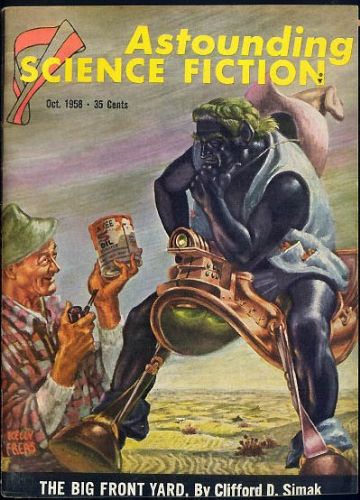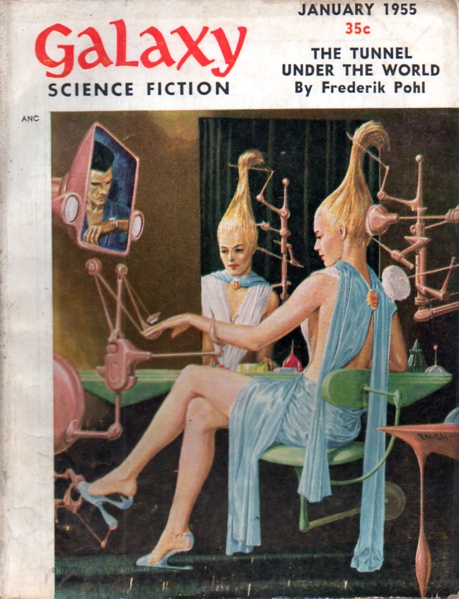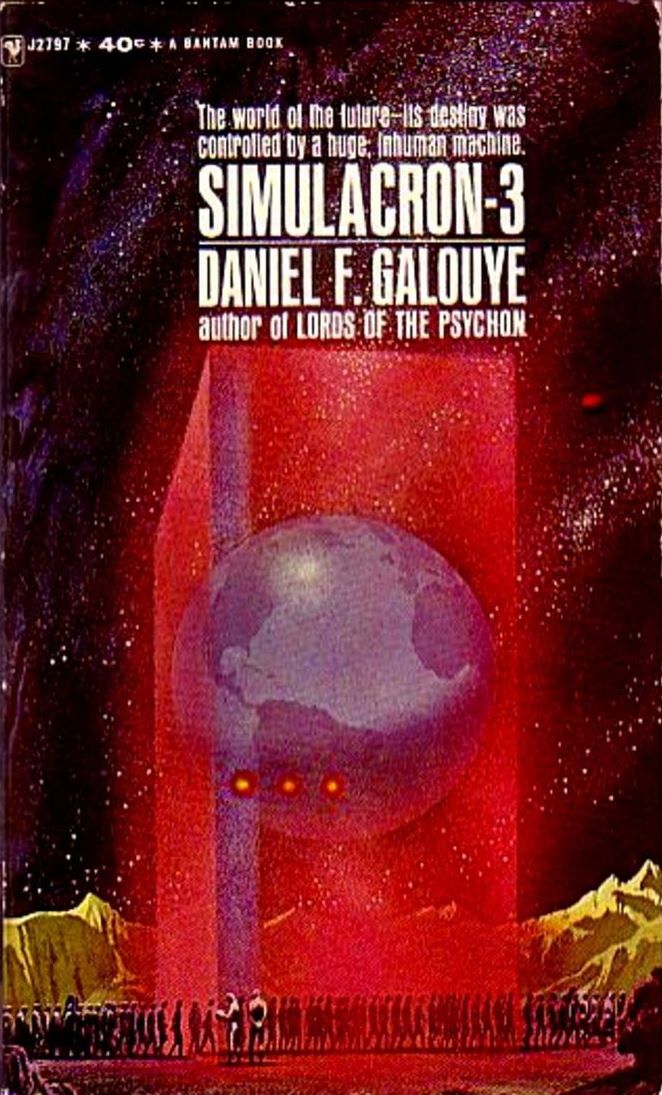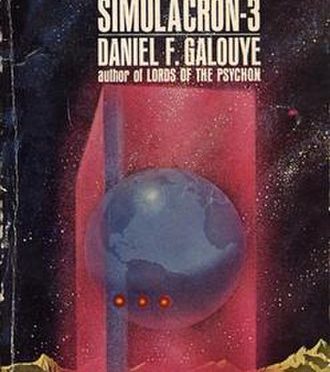
by Victoria Silverwolf
Life is But a Dream
I dreamed I was a butterfly, flitting around in the sky; then I awoke. Now I wonder: Am I a man who dreamt of being a butterfly, or am I a butterfly dreaming that I am a man?
— Zhuangzi, Chinese philosopher, 4th century BC

Science fiction writers have often pondered the nature of reality, and speculated about the ways in which appearances can be deceiving. Among the many stories making use of this theme, a few stand out as particularly thoughtful explorations of the real and the illusory.

Phillips didn't make the cover.
First published in Astounding half a dozen years ago, The Yellow Pill by Rog Phillips presents two characters with contradictory views of reality. Each believes the other to be hallucinating. The drug mentioned in the title changes their view of things, and it's up to the reader to decide who is right, if either. The story obviously had a strong impact on readers, as it has already been reprinted in anthologies in the USA and the UK, as well as being adapted into an episode of the British television series Out of This World.

Pohl did.
A few years earlier, Frederik Pohl tackled a similar idea in his story The Tunnel Under the World. The inhabitants of a small town live the same nightmarish day over and over again. It turns out that neither the community nor its inhabitants are what they seem to be. This powerful tale of deception and manipulation of reality must have struck a chord, as it was quickly adapted into an episode of the radio series X Minus 1.

Note that this was published not as science fiction, but as a novel of menace.
Philip K. Dick's novel Time Out of Joint explores related concepts in a surrealistic way. The protagonist thinks he lives in a typical American suburb in 1959, the year the book was published. The reader soon discovers that something is odd about this version of our mundane world, such as the fact that nobody has ever heard of Marilyn Monroe. Things get really bizarre when a soft-drink stand disappears, replaced with a small slip of paper bearing the words SOFT-DRINK STAND. Further weird breakdowns of a simulated reality lead the hero to discover the truth about the world and himself.
Bits and pieces of all three of these works came to mind as I read the latest novel from an author whose previous books won a great deal of praise from the Galactic Journeyers.
The Visionary From the Big Easy

The author at the time he started publishing science fiction.
Born in New Orleans, Daniel Francis Galouye served in the US Navy during World War Two, returning to work as a journalist. Fortunately for SF fans, he doesn't limit his writing to reportage. Ever since 1952, he's appeared frequently in the genre magazines. It took him a while to make the leap into novels, but when he took the jump he did so with a splash.
Galouye's first book-length work, Dark Universe, made a big hit with our host, as well as with Hugo voters. It nearly took the prize, bested only by the unstoppable juggernaut of Robert A. Heinlein's controversial novel Stranger in a Strange Land, which was not so popular around here.
Although it was not nominated for a Hugo, Galouye's second novel, Lords of the Psychon, won plaudits from a Galactic Journeyer. Will he continue this lucky streak with his newest effort? Let's take a look and find out.
Planet of the Pollsters

The American edition, with anonymous cover art.

The British edition, with no cover art.
Simulacron-3, known in the United Kingdom as Counterfeit World, takes place in the middle of the 21st century. It's a technologically advanced place, with flying cars, moving pedestrian sidewalks, and many other wonders familiar to readers of futuristic fiction. The most noticeable change in society is that opinion polls dominate commercial and political life. One-quarter of all employees are engaged in this line of work, and answering their questions is mandatory. So far we have a satiric portrait of the business world, similar to the sort of thing Frederik Pohl and Cyril M. Kornbluth offered in their novel The Space Merchants, but Galouye has something else in mind.
Leaving the Party Too Soon
The narrator, Douglas Hall, works for business tycoon Horace P. Siskin, as a computer expert for Reactions, Incorporated (REIN). Like so many other companies in this future, REIN studies consumer reactions in order to determine which products will sell. The book begins with Douglas attending a party at Horace's fabulous mansion. He is about to take control of the Simulacron-3 project from the recently deceased Hannon Fuller, killed in what seems to be a freak accident.
Simulacron-3 is a computer-simulated community, inhabited by artificial people who interact with each other and their environment as if they were real. By studying their reactions to various situations, it is possible to determine how living persons would behave under the same circumstances. This threatens to eliminate the need for pollsters, putting them all out of work.
Morton Lynch, the security chief for REIN, shows up in an agitated state. He claims that Hannon discovered something of critical importance that led to his demise. Not much later, he simply vanishes into thin air. Douglas reports the disappearance, but nobody else even remembers that Morton ever existed. Because Douglas suffers from occasional blackouts, he begins to doubt his own sanity.
It Takes All the Running You Can Do to Stay in the Same Place
With the help of Hannon's adult daughter Jinx, Douglas searches through her father's papers. They find a drawing of an ancient Greek warrior and a tortoise. This is, of course, a reference to the famous Zeno paradox, in which Achilles can never catch up to the slow-moving animal. The relevance of the sketch is obscure, but it seems to be a vital clue to Hannon's secret. Whatever it may mean, it disappears quickly, and Jinx denies that she ever saw such a thing.
Tensions mount between REIN and the powerful pollsters organization, leading to mass demonstrations and the possibility of a violent attack on the company. As if Douglas didn't have enough problems, Siskin plans to use Simulacron-3 to predict voting behavior, in order to make himself the leader of a one-party state. Add to this the fact that Douglas narrowly escapes being killed, by a flying car and then a bomb, and our hero is in plenty of hot water. Complicating matters is the presence of Dorothy Ford, Siskin's personal secretary/mistress, who uses her seductive wiles to keep a close eye on Douglas in order to make sure he doesn't spill the beans about her employer's political ambitions. There's also the possibility that the police suspect Douglas murdered Hannon. The guy just can't catch a break!
I've mentioned a lot of characters, but I've also left out quite a few. The story involves a lot of plots and counterplots, with the narrator never quite sure who's working for him and who's working against him. Up to now we have a science fiction suspense story, with a whodunit aspect, but things are about to get a lot different.
Stop! Read No Further If You Don't Want to Learn the Big Secret!

Almost exactly halfway through the book, Galouye throws in a major plot twist. Astute readers may anticipate the revelation that follows, but others may not.
Are you sure you want to find out? Last chance to turn back. OK, here we go.
Douglas finds out that his entire world is a computer simulation, and that he himself is no more than an artificial human being living inside it. The rest of the novel deals with his effort to escape into the real world, while avoiding the efforts of the unseen, unknown, god-like person running the simulation to eliminate him.
It's Safe to Read Again
Simulacron-3 (or, if you prefer, Counterfeit World) is a fascinating, cleverly plotted novel, full of intriguing concepts and plenty of fast-paced action. If some parts are melodramatic, and if other aspects seem implausible, those are minor flaws compared to the intriguing theme. I suspect it will earn more praise for the author, and I wouldn't be too surprised if somebody adapts it into a movie someday; maybe even more than once!
Four stars.
Until next time, try to keep a grip on what's real!

An advertisement for a drug invented a few years ago.


I'm notoriously resistant to Galouye (I know I sound like a broken record there), but this one sounds interesting. I might actually go looking for it.
The first two "nature of reality" stories that crossed my mind were Heinlein's "They" and Ray Nelson's "Eight O'Clock in the Morning" from last fall.
Stranger in a Strange Land may not have been all that unstoppable a juggernaut. According to some accounts it beat Dark Universe by only two votes. Galouye is said to have voted for Stranger. If he had voted for his own novel there would have been a tie. A few years ago I collected and read all of Galouye's short fiction. Great stuff. One of the 30's classics with the theme of artificial reality is The Man Who Awoke by Lawrence Manning. One of the illustrations, people sleeping with plugged in helmets, would make a great visual for a future science fiction film.
Simulacron-3 reverberates down to the present. I ranted about simulations rerunning the past to Hans Moravec at the first Artificial Life conference. He wrote, "Pigs in cyberspace," which is perhaps the source of Nick Bostrom's interest. That made "the world as a simulation" into a cottage industry for philosophy departments.
Though I didn't realize it till later, reading Simulacron-3 was surely my inspiration for the rant. ("Do you realize how unlikely it is that this is the first time we have had this conversation?")
More recent thoughts:
There are good reasons to expect humans will never develop time travel in the base universe in which we live.
https://en.wikipedia.org/wiki/Niven%27s_laws#Niven's_Law_(re_Time_travel)
However, there is a way to get *subjective* time travel with an
uploaded civilization running in a simulated reality. And no
causality violations even if you snuff your grandfather.
All it requires is to checkpoint the hardware running the simulated reality from time to time. “Time travel” for an individual in such a context would amount to reloading a previous checkpoint (perhaps on new hardware) and entering the simulation. From a subjective viewpoint, this would be equivalent to time travel.
Limits, you can’t go back before the first checkpoint.
If anyone wants to write a story with this background, I would like to see the draft.
I happened to read SIMULACRON-3 last month, since Galouye's was the first iteration that I know of the "reality is just a computer simulation" trope and I wanted to see how he handled it.
I was struck by two things: –
[1] In Galouye's treatment, it's not such a big conceptual step from Fred Pohl's earlier 'The Tunnel Under the World' — where the characters turn out to be miniature robots in a tabletop simulation — to Galouye's computer simulation-based iteration of the notion. In both stories, advertising and polling and social manipulation are the rationale for the simulation's creation.
In short, Galouye's idea and treatment seem less stunningly original when one factors in that he'd have been quite familiar with Pohl's story. (And he clearly was, since Pohl as H.L. Gold's assistant editor at GALAXY probably bought more Galouye stories than any other magazine editor.)
[2] Galouye's prose qua prose in SIMULACRON-3 struck me as as clunky and in places as bad as any I've seen from any 1950s-60s era commercial hack. Bob Silverberg churning out his 4,000 words a day (or whatever it was) back in the 1950s wrote more competently. Galouye's novel as a whole — if the brilliance of its central idea is set aside — felt to me like a inept, talentless tenth-rater's attempt to do his version of a Pohl and Kornbluth-style SPACE MERCHANTS or GLADIATOR-AT-LAW type of novel.
Still … brilliant central idea!
Most of his early fiction appeared in Imagination/Imaginative Tales, middle period mostly in Galaxy/If, late period mostly Amazing/Fantastic. Other multiple sales to F&SF, Fantastic Universe.
It's next on my "to-read" list… after I finish Aldiss' Greybeard for review later this month.